This article has been reviewed according to Science X's editorial process and policies. Editors have highlighted the following attributes while ensuring the content's credibility:
fact-checked
reputable news agency
proofread
Climate change is fueling the disappearance of the Aral Sea. It's taking residents' livelihoods, too
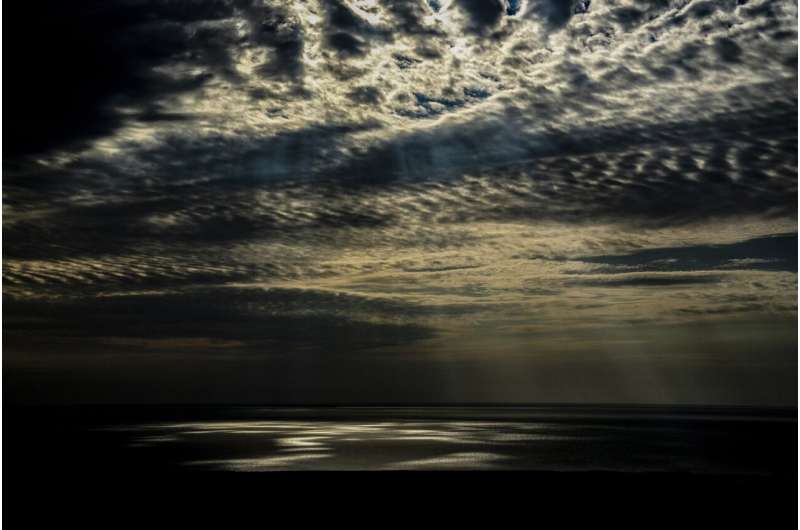
Toxic dust storms, anti-government protests, the fall of the Soviet Union—for generations, none of it has deterred Nafisa Bayniyazova and her family from making a living growing melons, pumpkins and tomatoes on farms around the Aral Sea.
Bayniyazova, 50, has spent most of her life near Muynak, in northwestern Uzbekistan, tending the land. Farm life was sometimes difficult but generally reliable and productive. Even while political upheaval from the Soviet Union's collapse transformed the world around them, the family's farmland yielded crops, with water steadily flowing through canals coming from the Aral and surrounding rivers.
Now, Bayniyazova and other residents say they're facing a catastrophe they can't beat: climate change, which is accelerating the decades-long demise of the Aral, once the lifeblood for the thousands living around it.
The Aral has nearly disappeared. Decades ago, deep blue and filled with fish, it was one of the world's largest inland bodies of water. It's shrunk to less than a quarter of its former size.
Much of its early demise is due to human engineering and agricultural projects gone awry, now paired with climate change. Summers are hotter and longer; winters, shorter and bitterly cold. Water is harder to find, experts and residents like Bayniyazova say, with salinity too high for plants to properly grow.
"Everyone goes further in search of water," Bayniyazova said. "Without water, there's no life."
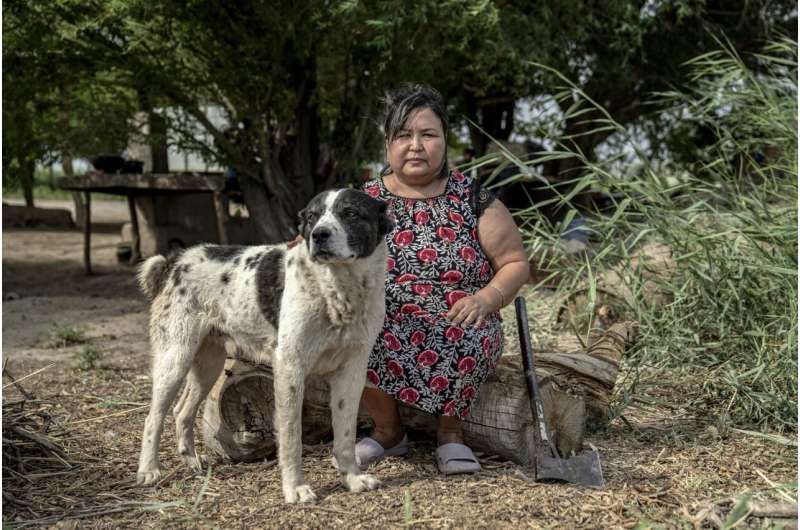
HISTORY AND DEMISE
For decades, the Aral—fed by rivers relying heavily on glacial melt, and intersecting the landlocked countries of Kazakhstan, Kyrgyzstan, Tajikistan, Turkmenistan and Uzbekistan—held meters-long fish, caught and shipped across the Soviet Union.
The region prospered, and thousands of migrants from across Asia and Europe moved to the Aral's shores, for jobs popping up everywhere from canning factories to luxury vacation resorts.
Today, the few remaining towns sit quiet along the former seabed of the Aral—technically classified as a lake, due to its lack of a direct outlet to the ocean, though residents and officials call it a sea. Dust storms whip through, and rusted ships sit in the desert.
In the 1920s, the Soviet government began to drain the sea for irrigation of cotton and other cash crops. By the 1960s, it shrunk by half; those crops thrived. By 1987, the Aral's level was so low it split into two bodies of water: the northern and southern seas, in Kazakhstan and Uzbekistan, respectively.
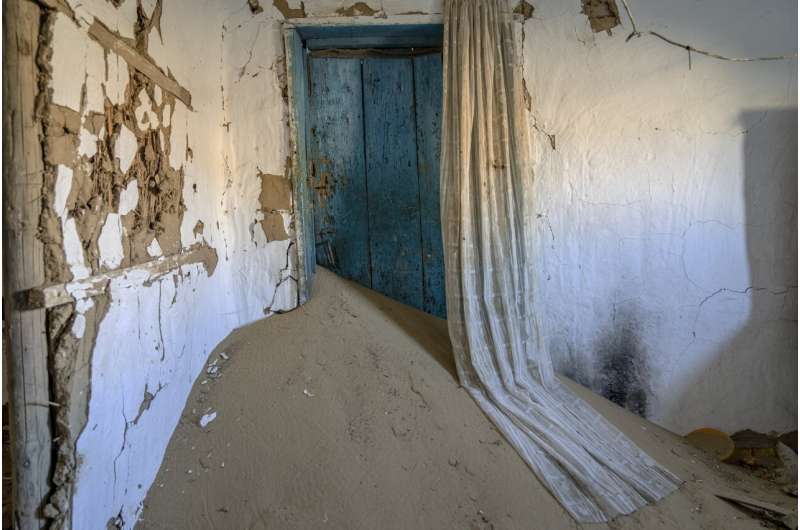
The United Nations Development Program calls the destruction of the Aral Sea "the most staggering disaster of the 20th century." It points to the Aral's demise as the cause of land degradation and desertification, drinking water shortages, malnutrition, and deteriorating health conditions.
National governments, international aid organizations and local groups have tried—with varying degrees of effort and success —to save the sea. Efforts range from planting bushes for slowing the encroaching dunes to building multimillion-dollar dams.
But experts say climate change has only accelerated the death of the Aral, and will continue to exacerbate residents' suffering.
"ONLY US LOCALS"
Without the moderating influence of a large body of water to regulate the climate, dust storms began to blow through towns. They whipped toxic chemicals from a shuttered Soviet weapons testing facility and fertilizer from farms into the lungs and eyes of residents, contributing to increased rates of respiratory diseases and cancer, according to the U.N.
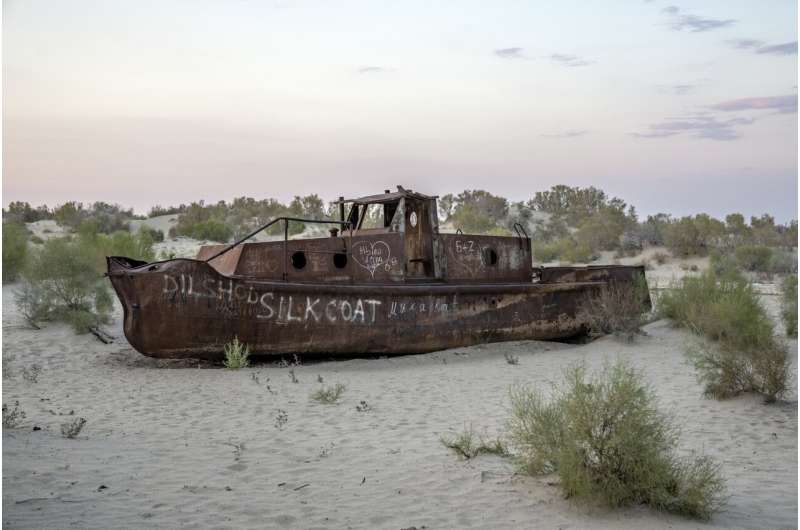
Fierce winds caused dunes to swallow entire towns, and abandoned buildings filled with sand. Residents fled. A dozen fish species went extinct, and businesses shuttered.
Madi Zhasekenov, 64, said he watched as his town's once-diverse population dwindled.
"The fish factories closed, the ships were stranded in the harbor, and the workers all left," said Zhasekenov, former director of the Aral Sea Fisherman Museum in Aralsk, Kazakhstan. "It became only us locals."
Dust storms, rising global temperatures, and wind erosion are destroying the glaciers the sea's rivers rely on, according to a U.N. report. The remaining water is getting saltier and evaporating faster.
Melting ice and changing river flows may further destabilize drinking water supply and food security, the report warns, and hydropower plants could suffer.
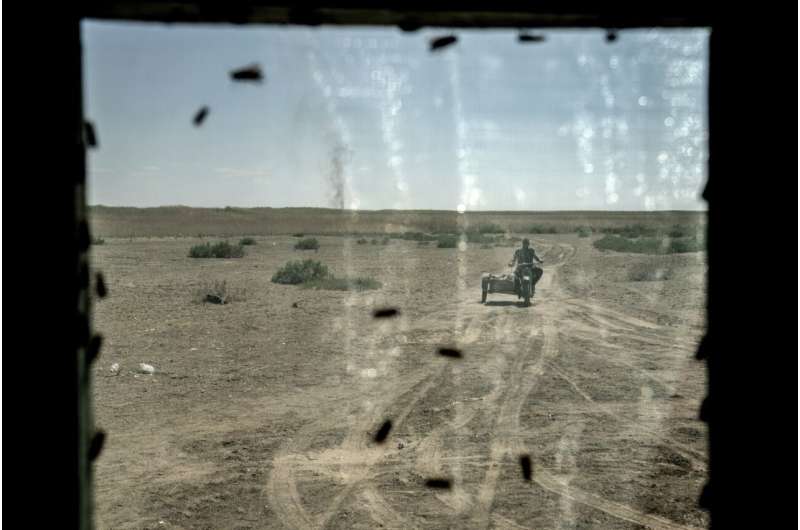
During a recent summer in the small desert village of Tastubek, Kazakhstan, farmer Akerke Molzhigitova, 33, watched as the grass her horses fed on dried up from extreme heat. To try and save them—a major source of income and food—she moved them 200 kilometers (125 miles) away.
Still, dozens died. Her neighbors, fearing the same fate, sold their animals.
CONTRAST ALONG THE ARAL
Near Sudochye Lake in Uzbekistan, Adilbay and his friends fish in the Aral's remaining water pockets. Their catch is tiny.
He holds his arms wide, the size of fish from years ago. "Now there is nothing," said Adilbay, 62, who goes by only one name.
As the water disappeared, a nearby fish processing warehouse closed. Adilbay's friends and relatives moved to Kazakhstan, seeking new jobs.
There, fisherman Serzhan Seitbenbetov, 36, and others find success. Sitting in a boat rocking in gentle waves, he pulled his net. In an hour, he hauled in a hundred fish, some 2 meters (6.5 feet) long. He'll make 5000 Kazakhstani Tenge ($10.50), he said—five times his previous daily pay as a taxi driver in a neighboring city.
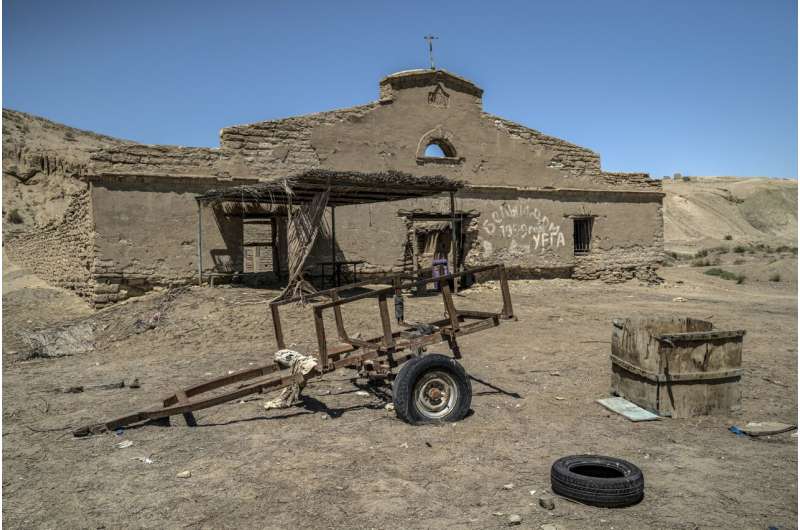
"Now all the villagers make good money being fishermen," he said.
That's the result of an $86 million dike project led by Kazakhstan, with assistance from the World Bank, completed in 2005.
Known as the Kokaral Dam, the dike cuts across a narrow stretch of the sea, conserving and gathering water from the Syr Darya River. The dike surpassed expectations, leading to an increase of over 10 feet in water levels after seven months.
That helped restore local fisheries and affected the microclimate, causing an increase in clouds and rainstorms, according to the World Bank. Population grew.
But it couldn't replicate life before the water started drying up, said Sarah Cameron, an associate professor at the University of Maryland who's writing a book about the Aral.
"It does not support the same amount of people and the fishing industry in the same way," Cameron said.
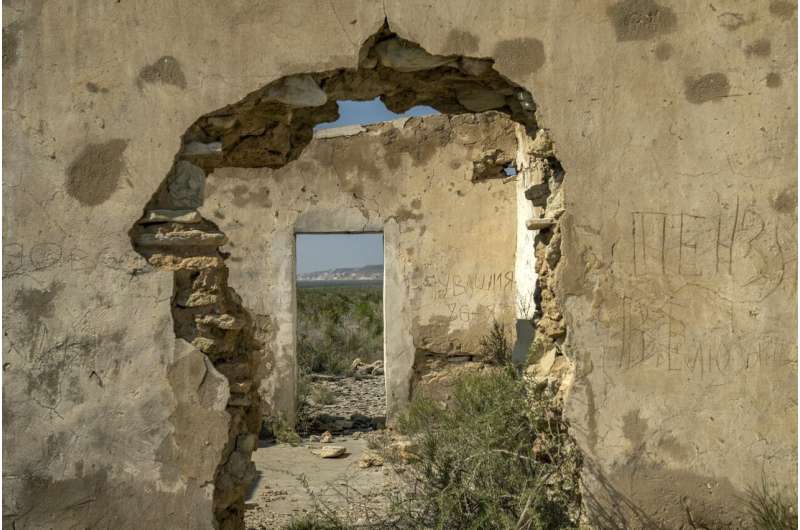
And building the dike in Kazakhstan cut off the south part of the sea in Uzbekistan from its crucial water source.
Uzbekistan has been less successful in restoration efforts. The government hasn't undertaken large projects like the Kokaral. Instead, the country planted saxaul trees and other drought-resistant plants to help prevent erosion and slow dust storms.
Agriculture, especially the export of water-intensive cotton, continued to be a main staple of the economy. Millions of people worked—for years in forced-labor campaigns—in the cotton-picking industry, which further sapped water resources.
The discovery of oil and natural gas in the Aral's former seabed brought the building of gas production facilities—and shows Uzbekistan has little interest in restoration, experts said.
"While there has been some restoration," said Kate Shields, assistant professor in environmental studies at Rhodes College, "there was a sort of an acceptance that ... the sea was not coming back."
Government officials from Uzbekistan and Kazakhstan didn't respond to questions emailed by AP about restoration efforts, water scarcity and the effects of climate change.
-
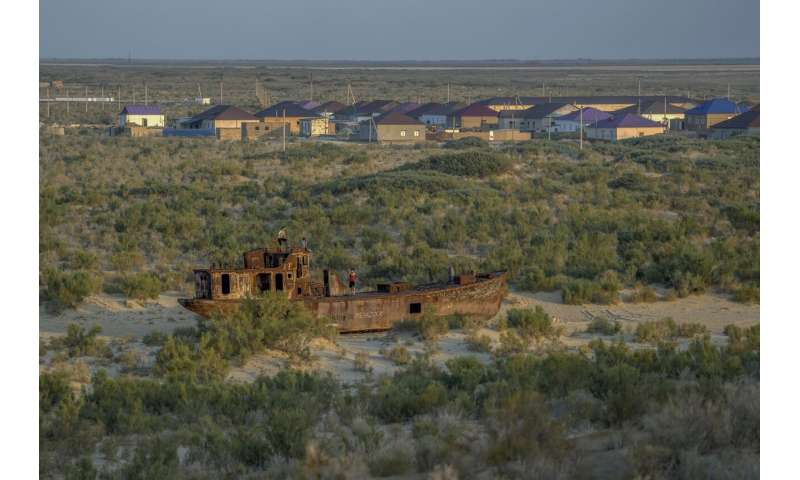
A rusting ship sits in a dried-up area of the Aral Sea in Muynak, Uzbekistan, Sunday, June 25, 2023. The demise of the once-mighty sea has affected thousands of residents and their livelihoods for decades. Credit: AP Photo/Ebrahim Noroozi -
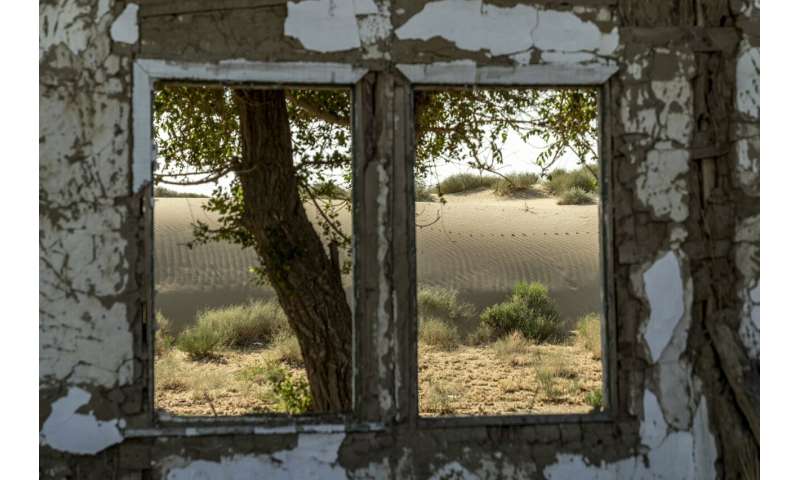
A hill of sand is visible through a destroyed home on the edge of the dried-up Aral Sea near Tastubek, Kazakhstan, Monday, July 3, 2023. The hazardous conditions around the Aral include toxic dust storms, towns that are swallowed by dunes, water salination and evaporation, drier winters and hotter summers. Credit: AP Photo/Ebrahim Noroozi -
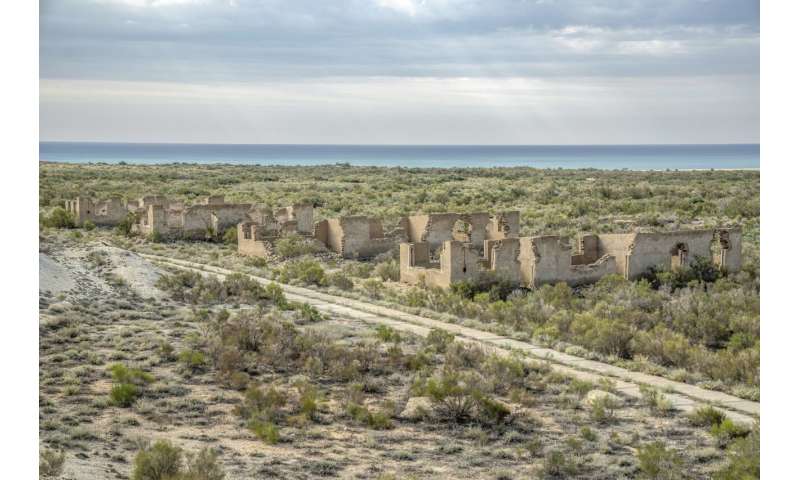
A former military base that was destroyed and evacuated after the drying up of the Aral Sea is visible in the former Aral Sea seabed Uzbekistan, Sunday, June 25, 2023. Credit: AP Photo/Ebrahim Noroozi -
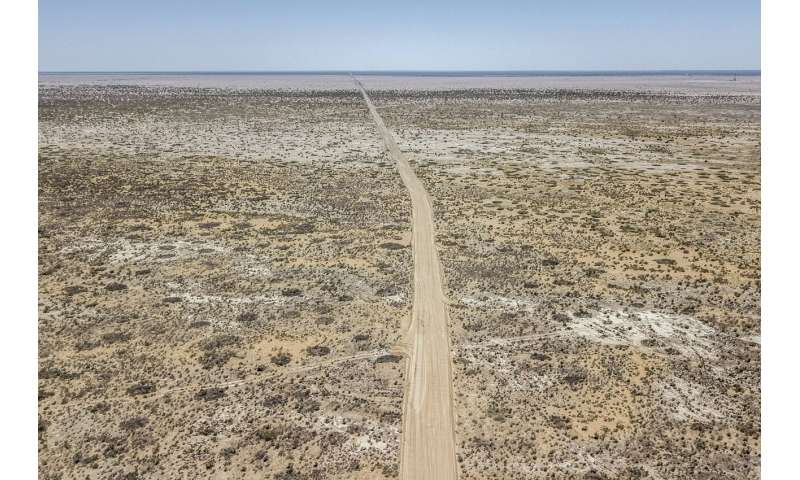
A dirt road stretches through the desert that used to be the bed of the Aral Sea, on the outskirts of Muynak, Uzbekistan, Tuesday, June 27, 2023. The drying up of the once-mighty sea has affected thousands of residents and their livelihoods for decades. Credit: AP Photo/Ebrahim Noroozi -
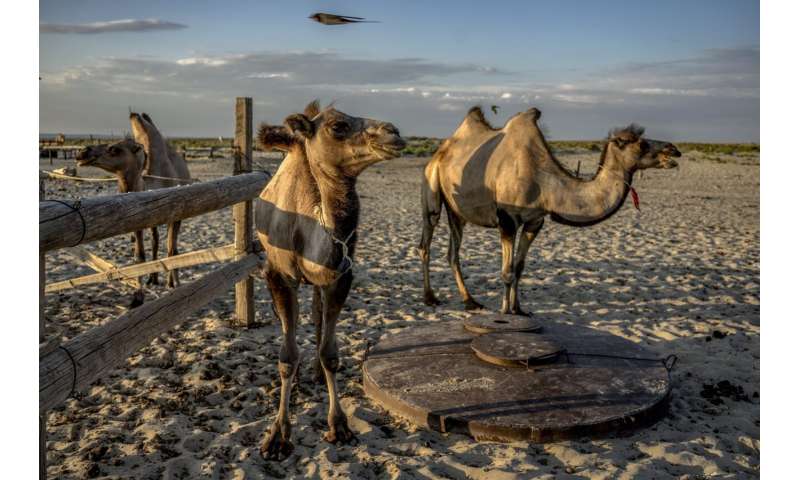
Camels gather next to a well in the desert that used to be the bed of the Aral Sea next to the village of Tastubek near Aralsk city, Kazakhstan, Monday, July 2, 2023. Credit: AP Photo/Ebrahim Noroozi -
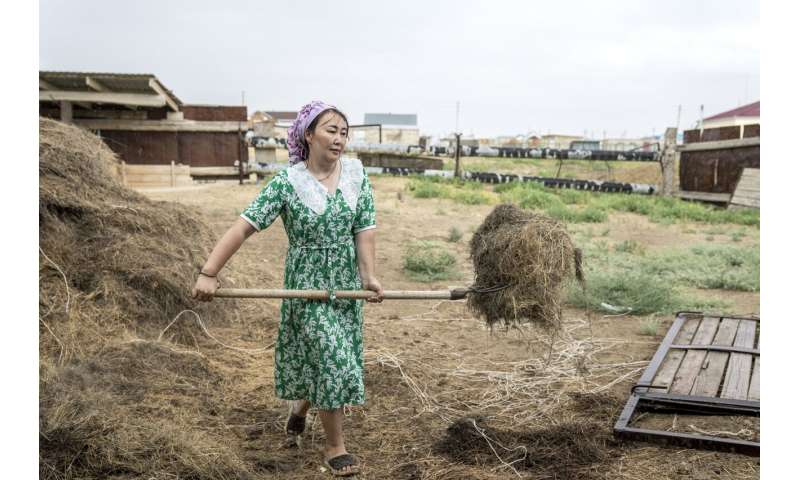
Akerke Molzhigitova prepares the food for camels early in the morning, along the dried-up Aral Sea, in the village of Tastubek near the Aralsk city, Kazakhstan, Sunday, July 1, 2023. Credit: AP Photo/Ebrahim Noroozi -
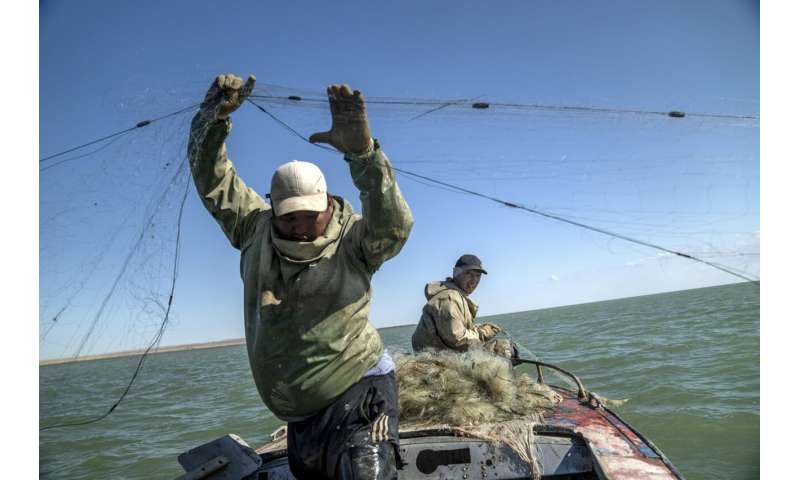
Serzhan Seitbenbetov, left, and Omirserik Ibragimov fish in a part of the Aral Sea with water, far away from their village Tastubek, outside Aralsk, Kazakhstan, Sunday, July 1, 2023. Credit: AP Photo/Ebrahim Noroozi -
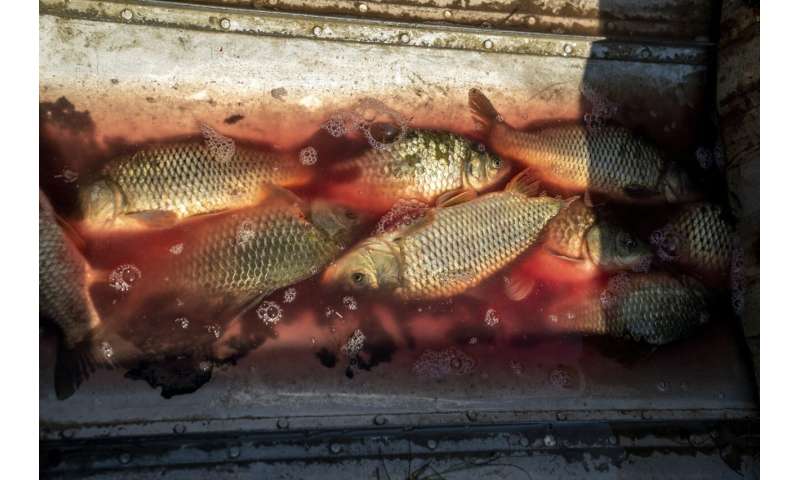
Fish taken from the Aral Sea sit in water on the bottom of a boat outside the village of Tastubek, Kazakhstan, Sunday, July 1, 2023. Fisheries have been restored thanks to a dike that cuts across a narrow stretch of the sea, conserving and gathering water that comes from the Syr Darya. Credit: AP Photo/Ebrahim Noroozi -
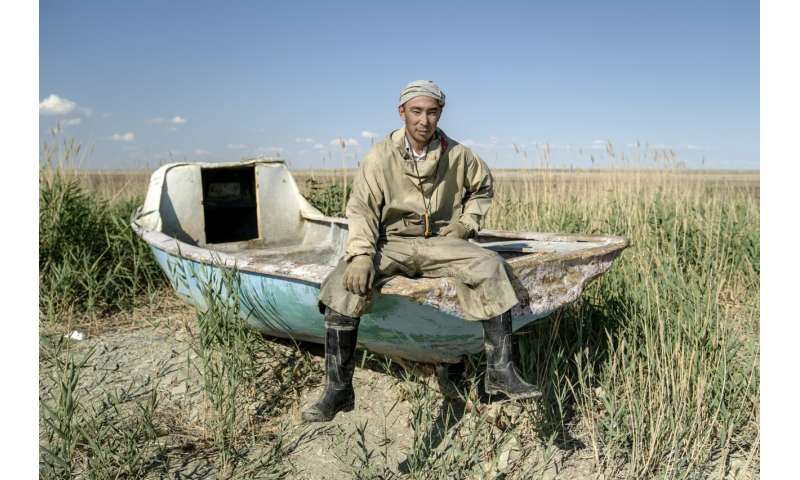
Omirserik Ibragimov, from the village of Tastubek, poses for a photo outside Aralsk, Kazakhstan, Sunday, July 1, 2023. Credit: AP Photo/Ebrahim Noroozi -

People play cards on the way to Aralsk, Kazakhstan, Friday, June 30, 2023. Credit: AP Photo/Ebrahim Noroozi -

A man waits for a train at the Aralsk city train station under a mural from the Soviet era, in Kazakhstan, Tuesday, July 4, 2023. Credit: AP Photo/Ebrahim Noroozi -

Youths gather to celebrate graduation in the area that used to be the main port of the region before the Aral Sea dried up, Aralsk, Kazakhstan, Wednesday, July 5, 2023. Credit: AP Photo/Ebrahim Noroozi -
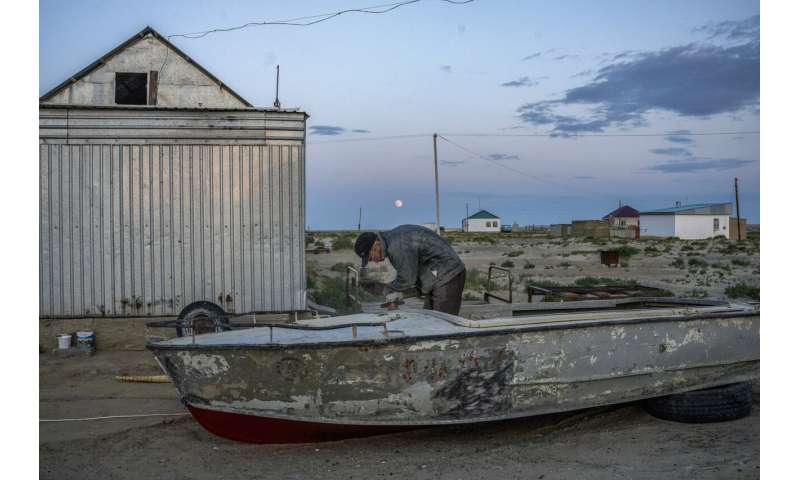
A man repairs an old boat along the dried-up Aral Sea, in the village of Tastubek near the Aralsk city, Kazakhstan, Monday, July 2, 2023. The demise of the once-mighty sea has affected thousands of residents and their livelihoods for decades. Credit: AP Photo/Ebrahim Noroozi -
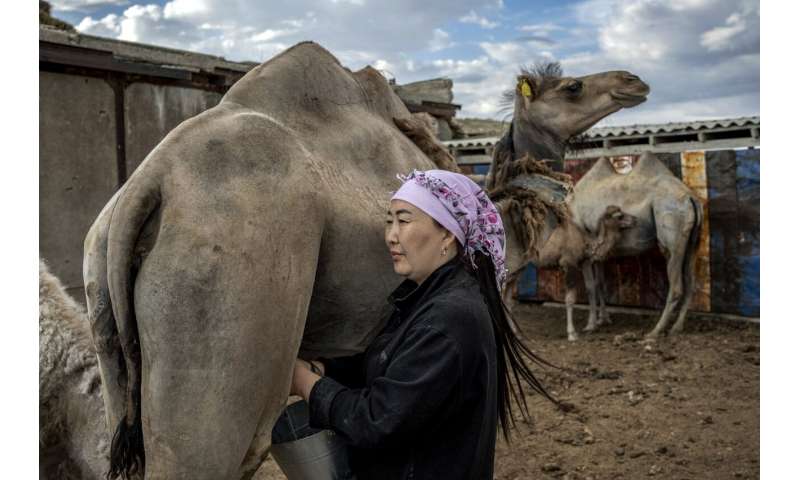
Akerke Molzhigitova milks camels early in the morning before sending them to the desert, along the dried-up Aral Sea, in the village of Tastubek, near Aralsk, Kazakhstan, Monday, July 2, 2023. Credit: AP Photo/Ebrahim Noroozi -
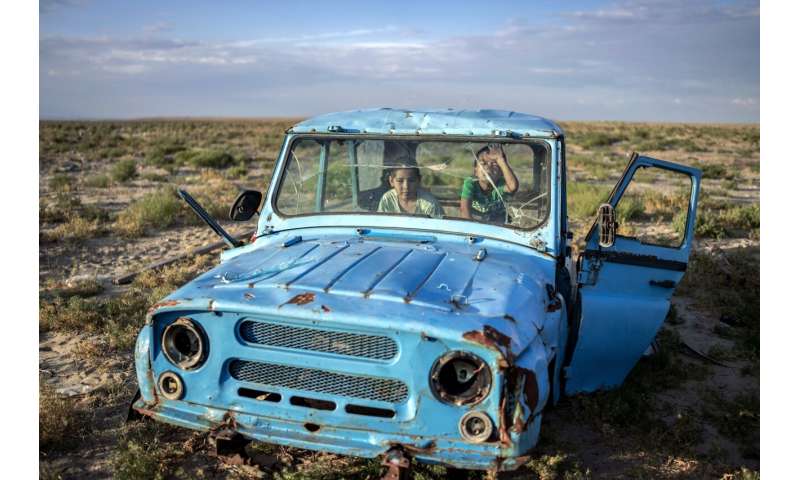
Children play inside a rusted dilapidated car along the dried-up Aral Sea, in the village of Tastubek near Aralsk, Kazakhstan, Monday, July 2, 2023. Credit: AP Photo/Ebrahim Noroozi -
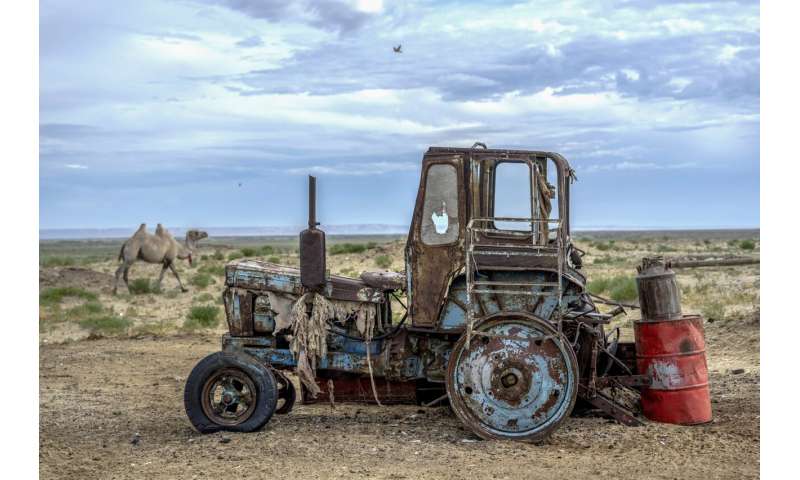
A rusted dilapidated tractor can sits along the dried-up Aral Sea, in the village of Tastubek, near Aralsk, Kazakhstan, Saturday, July 1, 2023. The demise of the once-mighty sea has affected thousands of residents and their livelihoods for decades. Credit: AP Photo/Ebrahim Noroozi -
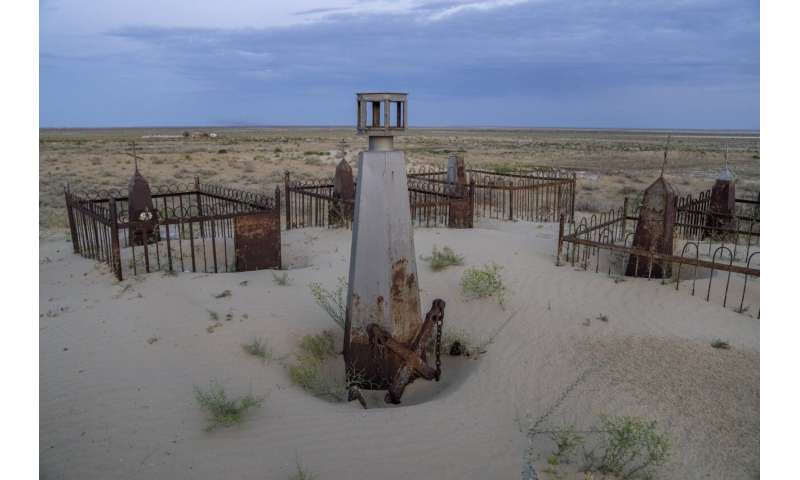
Graves, one with an anchor, are covered with sand along the dried-up Aral Sea near the city of Aralsk, Kazakhstan, Monday, July 3, 2023. Credit: AP Photo/Ebrahim Noroozi -
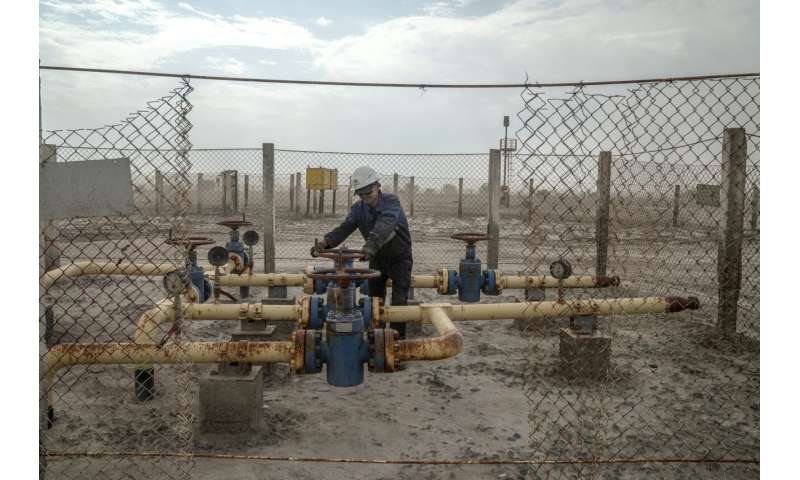
A person works in a gas field that was built in the desert that used to be the bed of the Aral Sea, on the outskirts of Muynak, Uzbekistan, Sunday, June 25, 2023. The discovery of oil and natural gas in the Aral's former seabed brought the building of gas production facilities, and shows that Uzbekistan has little interest in restoration, experts said. Credit: AP Photo/Ebrahim Noroozi -

Nafisa Bayniyazova works in her tomato greenhouse near Muynak, Uzbekistan, Wednesday, June 28, 2023. Bayniyazova and other residents say they're facing a catastrophe they can't beat: climate change, which is accelerating the decades-long demise of the Aral Sea, once the lifeblood for the thousands living around it. Credit: AP Photo/Ebrahim Noroozi -
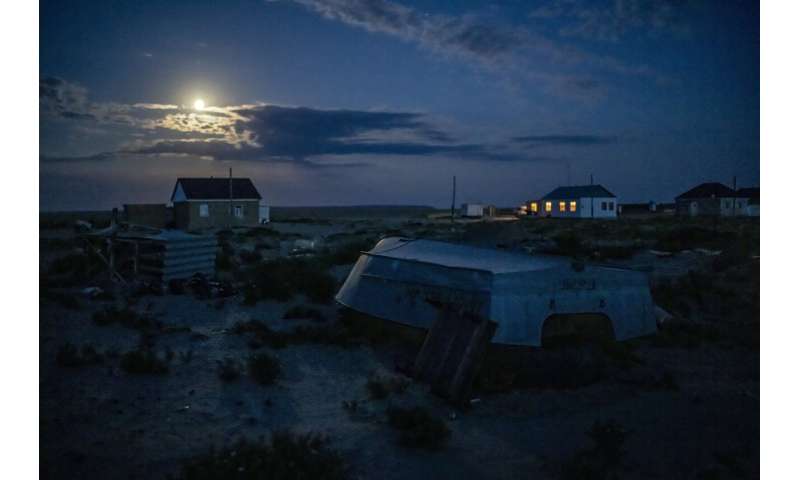
A worn-out boat sits along the dried Aral Sea, in the village of Tastubek near Aralsk, Kazakhstan, Sunday, July 2, 2023. The demise of the once-mighty sea has affected thousands of residents and their livelihoods for decades. Credit: AP Photo/Ebrahim Noroozi
"BARELY SURVIVING"
On her Uzbekistan farm, Bayniyazova's family has dug an earthen well, hoping to hold on to the precious little water that's left.
"If there is no water, it will be very difficult for people to live," Bayniyazova said. "Now people are barely surviving."
She doesn't plan to leave her farm yet but knows more hardships are likely ahead. Her family will dig deeper wells, see smaller harvests. They'll do whatever it takes to hang on to the only life they've known.
"We'll do everything we can," she said. "Because what else can we do?"
© 2024 The Associated Press. All rights reserved. This material may not be published, broadcast, rewritten or redistributed without permission.





















